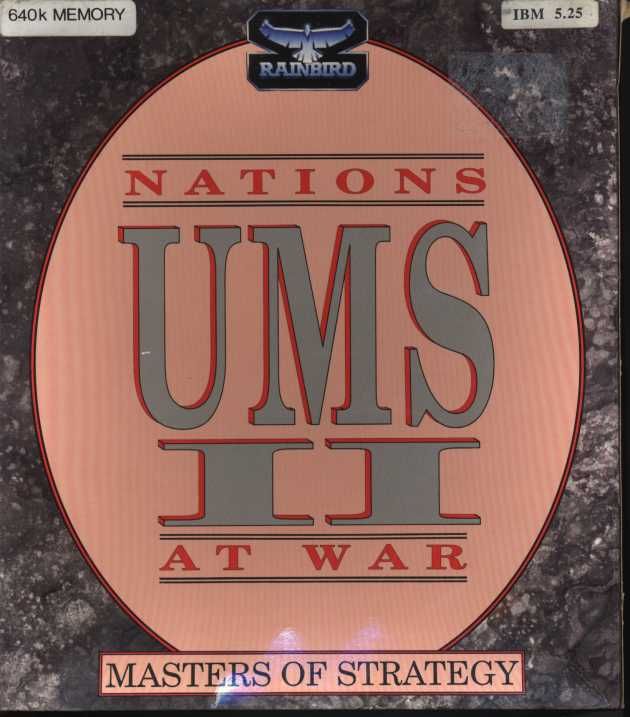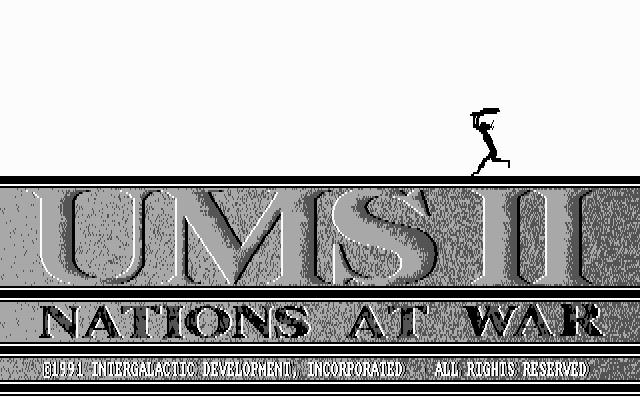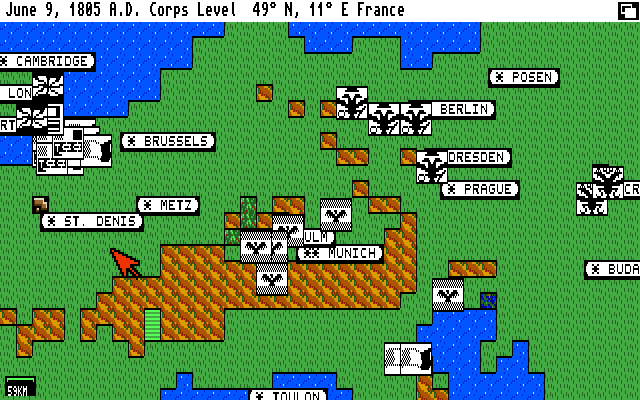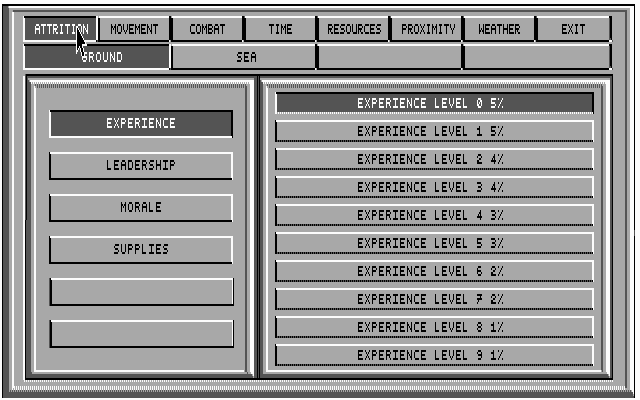Retro Replay Review
Gameplay
UMS II: Nations at War delivers an impressively deep strategic simulation that places every aspect of a battle at your fingertips. Building on its 1988 predecessor, the game offers players granular control over unit formations, supply lines, and terrain advantages, ensuring that no two engagements play out in exactly the same way. From positioning infantry on hilltops to coordinating cavalry charges, the level of detail encourages careful planning and rewards tactical foresight.
(HEY YOU!! We hope you enjoy! We try not to run ads. So basically, this is a very expensive hobby running this site. Please consider joining us for updates, forums, and more. Network w/ us to make some cash or friends while retro gaming, and you can win some free retro games for posting. Okay, carry on 👍)
One of the standout features is the inclusion of multiple historical scenarios, spanning from the beaches of Normandy in 1944 to the phalanx formations of Alexander the Great in 334 B.C., and the grand Napoleonic clashes at Trafalgar, Austerlitz, Borodino, and Waterloo. Each battle presents unique challenges: weather conditions, troop morale, and evolving objectives keep the experience fresh. For players looking to extend the replay value, the UMS Planet Edition scenario editor lets you craft custom maps and set your own rules, ensuring nearly endless battlefield permutations.
The interface, while rich in options, comes with a learning curve. Novices may feel overwhelmed by the number of menus and toggles required to fine-tune supply distribution or set unit engagement orders. That said, the game provides in-depth documentation, tooltips, and scenario briefings to guide you through early encounters. Once you’ve mastered the basic controls, you’ll find that UMS II’s depth becomes its greatest strength, offering a rewarding “aha” moment when your meticulously planned strategies pay off.
AI opponents vary in sophistication based on scenario difficulty, with higher levels demonstrating clever flanking maneuvers and timely reinforcements. The challenge ramps up organically, encouraging you to refine your tactics rather than relying on brute force. Multiplayer hotseat mode also adds a social dimension, as you and a friend can take turns issuing orders on the same map—a classic touch that reinforces UMS II’s old-school strategy pedigree.
Graphics
UMS II’s visuals are grounded in late-80s and early-90s strategy game aesthetics, featuring a top-down map view with simple hexagonal or square grid overlays, depending on the scenario. Unit icons are functional rather than flamboyant: infantry are represented by stylized silhouettes, cavalry by small horse motifs, and artillery by little cannon emblems. While these graphics won’t rival modern 3D renderings, they convey vital information clearly, making it easy to distinguish unit types at a glance.
Terrain tiles—plains, forests, hills, rivers—are depicted with straightforward color palettes that blend form and function. Forests appear as clustered green splotches, while hills use subtle shading to indicate elevation. This minimalist approach keeps the focus on strategy rather than eye candy, though you may find yourself missing dynamic lighting and particle effects seen in contemporary titles. Still, the clean layout ensures that even large-scale battles remain readable.
Scenario introduction screens and menu interfaces feature period-appropriate artwork and background textures that evoke the feel of a military manual. While they lack the polish of today’s UI animations, these design choices contribute to the game’s old-school charm. Tooltips and data panels scroll smoothly, even on modern hardware, and the absence of screen lag during large unit movements keeps the action flowing.
For players who appreciate mods, the Planet Edition’s tile-set and unit graphic files can be tweaked or replaced, allowing community members to create higher-resolution sprites or entirely new factions. Though few widespread mods exist, the option underscores UMS II’s flexibility and enduring appeal to dedicated wargamers who don’t mind rolling up their sleeves and customizing visuals to their liking.
Story
Unlike narrative-driven adventure games, UMS II is structured around a series of standalone historical scenarios rather than a linear plot. Each scenario comes with a concise briefing that sets the political and military context: the stakes of Normandy’s D-Day landings, Alexander’s push into Persia, or Napoleon’s gambit at Waterloo. These write-ups aren’t cinematic epics, but they do ground you in the motivations and constraints of each campaign.
The absence of cutscenes or character development is offset by the game’s emphasis on authentic troop deployments and orders of battle. You’ll find historically accurate unit rosters, commanders with period-specific capabilities, and victory conditions that mirror actual strategic objectives—securing key bridgeheads, neutralizing enemy artillery, or maintaining territorial control for a set number of turns. This authenticity serves as the “story,” immersing players in the operational challenges faced by real generals.
For those who crave more narrative, community-built scenarios occasionally introduce custom backstories or dramatic twists that complement the historical core. These player-created campaigns can add subplots—supply convoy ambushes, surprise reinforcements, or time-sensitive objectives—that inject a role-playing flair into the otherwise austere simulation. While not officially supported with voice acting or scripted events, these fan expansions demonstrate UMS II’s storytelling potential when harnessed by creative users.
Ultimately, UMS II’s story lies in the ebb and flow of simulated warfare itself. As you issue orders, adapt to battlefield surprises, and see units falter or surge forward, you craft your own narrative of triumphs and setbacks. This emergent storytelling, born from tactical decision-making rather than cutscenes, makes each replay a new chapter in an ongoing military saga.
Overall Experience
UMS II: Nations at War is a quintessential classic for serious strategy enthusiasts who relish deep, methodical wargaming. It demands patience and a willingness to learn intricate systems, but rewards thoughtful players with richly detailed simulations of legendary battles. The broad scenario selection ensures that you’ll never run out of challenges—from the pharaonic formations of antiquity to the smoke-choked fields of Waterloo.
While its retro graphics and text-heavy interface may feel dated compared to slick modern titles, the game’s depth compensates for any aesthetic shortcomings. The scenario editor, in particular, extends the title’s lifespan: designing your own theaters of war and sharing them with friends keeps the experience fresh long after you’ve mastered the included campaigns.
Neophytes to the wargame genre should be prepared for a steep learning curve. UMS II expects you to think like a general, poring over supply lines, morale levels, and terrain modifiers. But for players who view each setback as an opportunity to refine their strategy, this game embodies the essence of turn-based warfare: careful planning, judicious risk-taking, and the satisfaction of out-maneuvering a worthy foe.
In a landscape dominated by fast-paced action, UMS II stands out as a thoughtful, data-driven alternative. Its commitment to historical accuracy, combined with flexible customization tools, offers a gaming experience that is as educational as it is entertaining. If you’re seeking a deep dive into military tactics and a platform for your own strategic creativity, UMS II: Nations at War deserves a place on your virtual shelf.
 Retro Replay Retro Replay gaming reviews, news, emulation, geek stuff and more!
Retro Replay Retro Replay gaming reviews, news, emulation, geek stuff and more!









Reviews
There are no reviews yet.